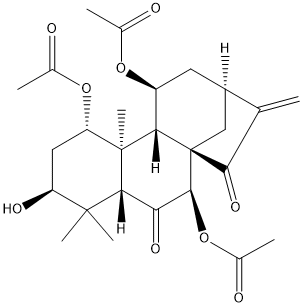|
|
| | Adenanthin Basic information |
| Product Name: | Adenanthin | | Synonyms: | Adenanthin;Actinodephnine Acuminatin Acuminatoside Adenanthin;Kaur-16-ene-6,15-dione,1,7,11-tris(acetyloxy)-3-hydroxy-, (1a,3b,7b,11b)- (9CI);Kaur-16-ene-6,15-dione, 1,7,11-tris(acetyloxy)-3-hydroxy-, (1α,3β,7β,11β)- | | CAS: | 111917-59-0 | | MF: | C26H34O9 | | MW: | 490.55 | | EINECS: | | | Product Categories: | | | Mol File: | 111917-59-0.mol |  |
| | Adenanthin Chemical Properties |
| Boiling point | 593.4±50.0 °C(Predicted) | | density | 1.29±0.1 g/cm3(Predicted) | | pka | 14.13±0.70(Predicted) |
| | Adenanthin Usage And Synthesis |
| Enzyme inhibitor | This diterpenoid (FW = 484.63 g/mol; CAS 111917-59-0) from the leaves of Rabdosia adenantha, induces differentiation of acute promyelocytic leukemia (APL) cells. Adenanthin targets the conserved cysteine thiols of peroxiredoxins I and II (or Prx I and Prx II), inhibiting their peroxidase activities and consequently increasing cellular hydrogen peroxide. The latter leads to the activation of Extracellular signal-Regulated Kinases (ERKs) and increased transcription of CCAAT/enhancer-binding protein β (or C/EBPs), further contributing to differentiation. Adenanthin induces APL-like cell differentiation, represses tumor growth in vivo and prolongs the survival of mouse APL models that are sensitive and resistant to retinoic acid. |
| | Adenanthin Preparation Products And Raw materials |
|